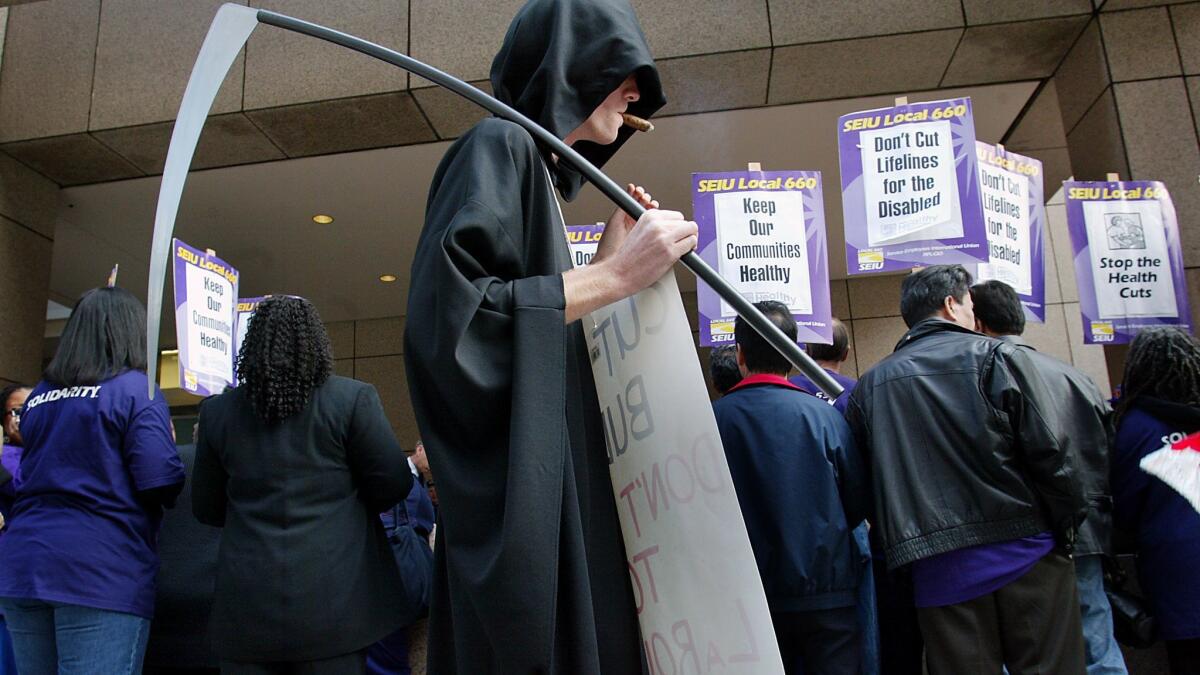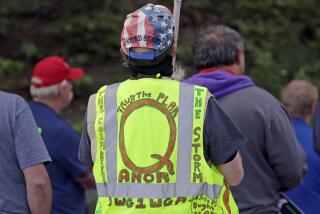Lyndon LaRouche Jr., conspiracy theorist who ran for president again and again, dies at 96
Often described as an extremist crank and fringe figure, Lyndon H. LaRouche Jr. cut a shadowy and alarming path through American politics for a half-century. He built a political organization often likened to a cult and ran for president eight times, once while in prison for mail fraud. In recent decades, he operated from a heavily guarded compound near Leesburg, Va.
LaRouche, who built a worldwide following based on conspiracy theories, predictions of economic doom, anti-Semitism, homophobia and racism, died Tuesday. He was 96.
His political organization, LaRouche PAC, confirmed the death but did not say where or how he died.
LaRouche drew headlines for his more outrageous claims: that England’s Queen Elizabeth II was a drug trafficker and that the International Monetary Fund created and spread the AIDS virus. He also said the CIA, KGB and British intelligence officials were plotting to assassinate him, according to a 1985 Washington Post profile that included interviews with followers.
LaRouchians, as the group was known, never numbered more than a few thousand, according to some estimates, but were a vocal, sometimes disturbing presence on the American political landscape. They heckled, harassed and occasionally threatened opponents.
His followers “made extraordinary inroads into American politics, surpassing the achievements of any other extremist movement in recent American history,” wrote Dennis King, a New York-based LaRouche expert in his 1989 book “Lyndon LaRouche and the New American Fascism.”
To say that Lyndon was slightly paranoid would be like saying the Titanic had a bit of a leak.”
— Jim Bakker
During the 1984 presidential election, LaRouche received more than 76,000 votes, his highest count. Calling himself a conservative Democrat that year, he aligned his followers with the strong military and defense posture of the Reagan White House.
His campaigns proved financially lucrative. By raising $5,000 in 20 states, he qualified for federal matching funds that brought his organization millions of dollars over the years.
His operation suffered a massive blow in 1988 after he was convicted of income-tax evasion, mail fraud and a scheme that took money without permission from the credit-card accounts of elderly donors. He served five years of a 15-year sentence and ran his 1992 campaign from a federal prison in Rochester, Minn.
In appearance, the bow-tie-sporting LaRouche was more avuncular than reactionary firebrand. He was raised in a Quaker family that was also drawn to fervent anti-communism. As a young adult, LaRouche seemed to reject his upbringing and became a socialist ideologue, but his rambling and paranoid style increasingly sidelined him within that marginal faction.
In the late 1960s, he attracted well-educated Vietnam-era liberals who found enlightenment in his stream-of-consciousness blend of philosophy, economics and science and his purported belief that the working class was endangered by a conspiracy between the Soviet Union and the United States.
Within a few years, his vision shifted far rightward and became ultraconservative and apocalyptic, and he presented himself as the moral savior of mankind.
LaRouche denounced those he deemed a danger to his cause — a rotating list of villains that included prosecutors, politicians, bankers and Zionists. LaRouche followers could be confrontational with those they viewed as dangers to society.
The LaRouche movement eventually became a multimillion-dollar industry, according to King. LaRouche’s properties included publications such as Executive Intelligence Review and political front groups such as the Fusion Energy Foundation, the Schiller Institute and the National Caucus of Labor Committees.

Lyndon Hermyle LaRouche Jr. was born in Rochester, N.H., on Sept. 8, 1922, and grew up in Lynn, Mass. His father, an executive at a shoe-manufacturing firm, also edited an anti-communist newspaper.
Bullied at school, young Lyndon was forbidden to fight back because of the family’s pacifist Quaker beliefs. He attended Northeastern University in Boston but left, according to his memoir, “The Power of Reason,” when teachers refused to indulge in his questioning of accepted truths in geometry class.
He was a conscientious objector at the outbreak of World War II and served as an Army medic in Burma, according to the 1985 Post profile.
LaRouche associates have said their leader was drawn to revolutionary politics after the war, inspired by India’s independence from British rule. He joined the Socialist Workers Party, a Trotskyist group. Later, in New York City, he led socialist study groups. He supported himself, at times, by working as a management consultant.
In 1977, LaRouche married Helga Zepp, a German-born LaRouche organizer. Suddenly, followers were expected to learn German, read German poetry and study German philosophy. The think tank he founded, the Schiller Institute, was led by his wife. They moved from New York to Loudoun County, Va., by the mid-1980s. A complete list of survivors was not immediately available.
One of LaRouche’s cellmates in Minnesota was disgraced televangelist Jim Bakker. In his autobiography, Bakker wrote that LaRouche was good-humored much of the time and impervious to the taunts of other inmates. He also was convinced their cell was bugged.
“To say that Lyndon was slightly paranoid,” Bakker wrote, “would be like saying the Titanic had a bit of a leak.”
More to Read
Start your day right
Sign up for Essential California for the L.A. Times biggest news, features and recommendations in your inbox six days a week.
You may occasionally receive promotional content from the Los Angeles Times.






